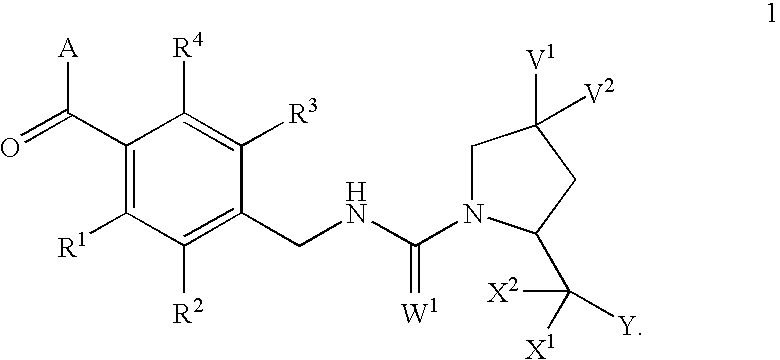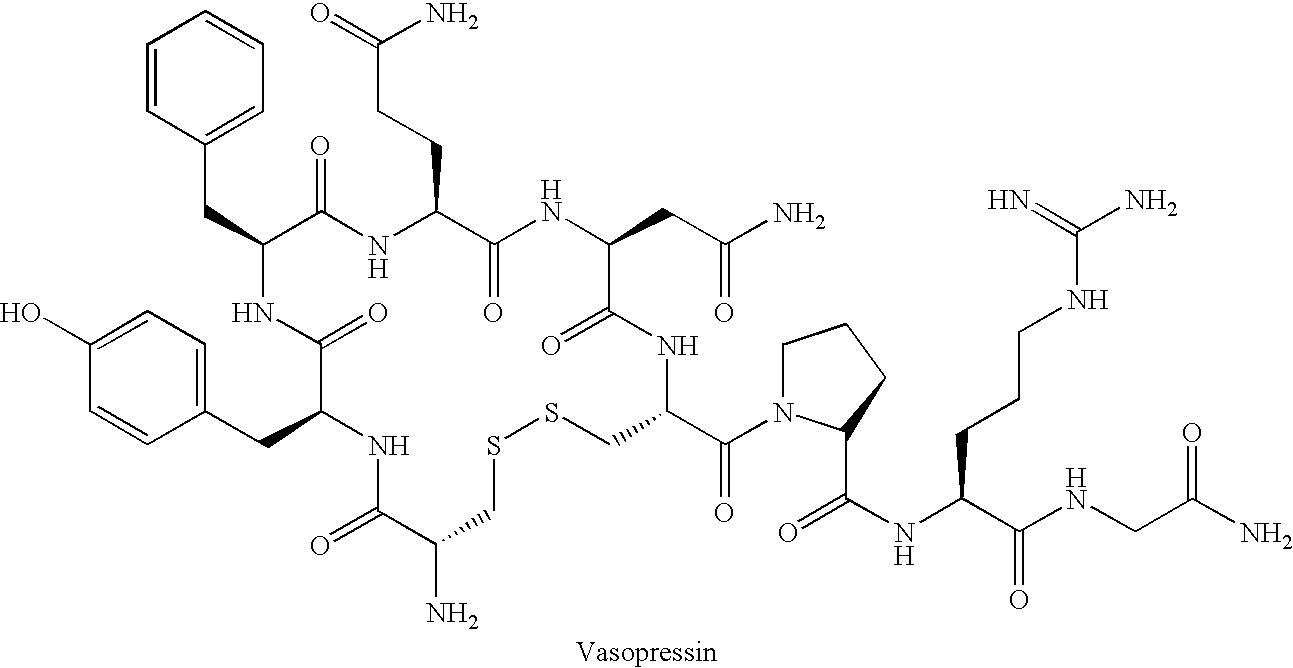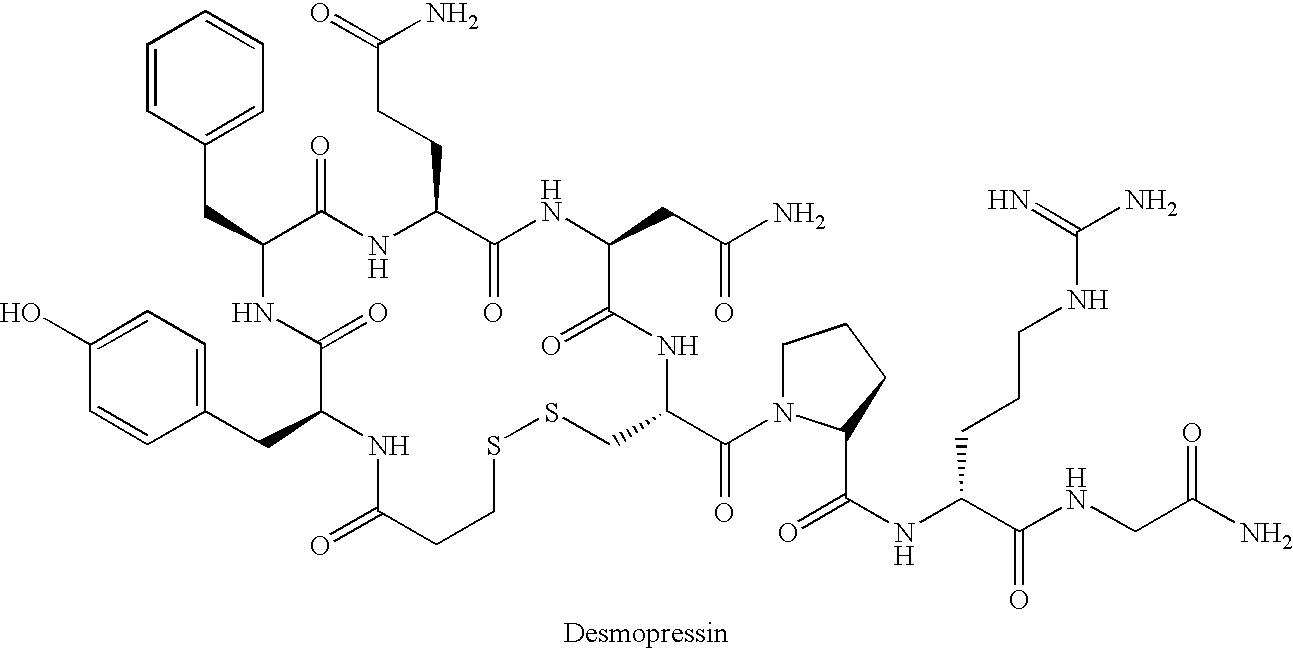Condensed azepines as vasopressin agonists
a technology of condensed azepines and vasopressin, which is applied in the direction of biocide, drug composition, extracellular fluid disorder, etc., can solve the problems of long current syntheses of desmopressin, inability to use desmopressin in the most convenient purification technique such as crystallisation, and inability to achieve the most convenient purification techniqu
- Summary
- Abstract
- Description
- Claims
- Application Information
AI Technical Summary
Benefits of technology
Problems solved by technology
Method used
Image
Examples
examples
Abbreviations
[0105]The following abbreviations have been used.
[0106]
AcAcetylAIBNAzo-bis-(isobutyronitrile)BnBenzylBOCtert-Butyloxycarbonyl(BOC)2ODi-tert-butyl dicarbonateDMFDimethylformamideEtEthylEtOAcEthyl acetateIPAIsopropanoliPrIsopropylM.S.Mass spectrometryMeMethylNBSN-Bromosuccinimidepet. etherpetroleum ether, fraction boiling at 60–80° C.PhPhenyltButert-ButylTHFTetrahydrofuranWSCDIWater-soluble carbodiimide
Preparation of Intermediates
[0107]Reagents corresponding to fragment A and C were commercially available or prepared according to the published procedures except where detailed in the specific Examples. Reagents corresponding to fragment B were prepared as detailed below.
example a
4-(tert-Butyloxycarbonylaminomethyl)-3-chlorobenzoic acid
[0108]
A1. Methyl 4-bromomethyl-3-chlorobenzoate
[0109]To a solution of methyl 3-chloro-4-methylbenzoate (5.0 g, 27.1 mmol) in carbon tetrachloride (50 ml) were added NBS (5.8 g, 32.0 mmol) and AIBN (0.442 g, 2.70 mmol). The mixture was stirred at reflux for 18 h. The mixture was allowed to cool to room temperature and then concentrated in vacuo. The residue was purified by flash chromatography on silica (eluant EtOAc:pet. ether 0:100 to 5:95); yield 5.96 g (84%).
A2. 4-(tert-Butyloxycarbonylaminomethyl)-3-chlorobenzoic acid
[0110]To a saturated solution of ammonia in ethanol (170 ml) was added methyl 4-bromomethyl-3-chlorobenzoate from Example A1 (5.5 g, 20.9 mmol). The mixture was stirred at room temperature for 1 h and then concentrated in vacuo. The residue was triturated with diethyl ether and the resultant white crystals were filtered off and washed with more diethyl ether. To a solution of this solid in water (100 ml) were ...
example b
4-Cyano-3-methylbenzoic acid
[0111]
[0112]To a solution of 4-bromo-2-methylbenzonitrile (2.0 g, 10.2 mmol) in THF (100 ml) at −78° C. under a nitrogen atmosphere was added dropwise a 2.5M solution of n-butyl lithium (4.48 ml, 11.2 mmol). The mixture was stirred at −78° C. for 1 h and then poured onto solid carbon dioxide (5 g) in THF (50 ml). The mixture was allowed to warm to room temperature. Water was added (200 ml) and the mixture was extracted with diethyl ether (3 times). The aqueous layer was acidified by addition of concentrated HCl and extracted with chloroform (3 times). The combined chloroform extracts were washed with water, dried over MgSO4, and concentrated in vacuo to give a white solid; yield 1.2 g (73%).
PUM
| Property | Measurement | Unit |
|---|---|---|
| voiding postponement | aaaaa | aaaaa |
| solubility | aaaaa | aaaaa |
| concentration | aaaaa | aaaaa |
Abstract
Description
Claims
Application Information
 Login to View More
Login to View More - R&D
- Intellectual Property
- Life Sciences
- Materials
- Tech Scout
- Unparalleled Data Quality
- Higher Quality Content
- 60% Fewer Hallucinations
Browse by: Latest US Patents, China's latest patents, Technical Efficacy Thesaurus, Application Domain, Technology Topic, Popular Technical Reports.
© 2025 PatSnap. All rights reserved.Legal|Privacy policy|Modern Slavery Act Transparency Statement|Sitemap|About US| Contact US: help@patsnap.com



